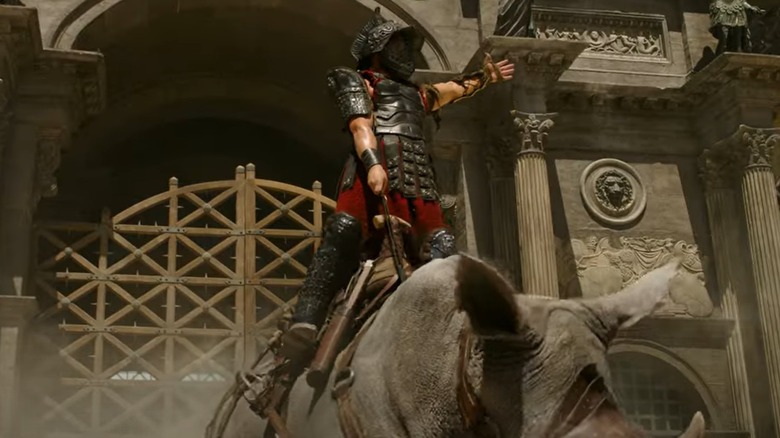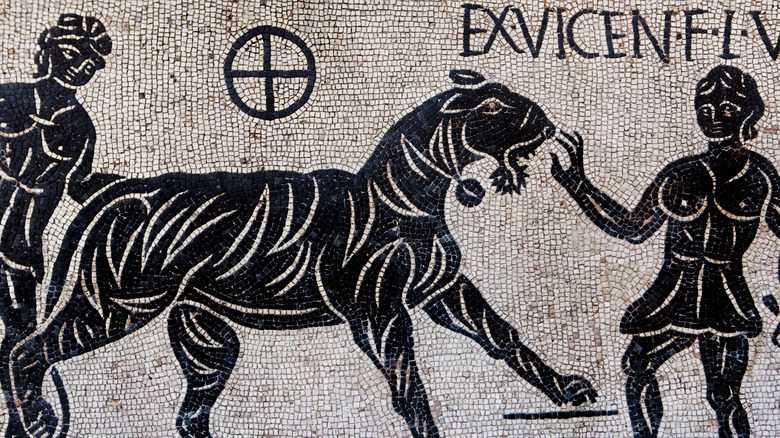The Truth About Gladiators Fighting Sharks And Rhinos In The Colosseum
If we can say one thing for certain about ancient Romans, it's that they loved their blood sport (curse tablets, anyone?). Talk of the ancient Colosseum in Rome tends to conjure images of armored dudes wielding exotic weapons and facing off against each other in a hot, dirt circle with a raving crowd surrounding them. That's not too off the mark. But while one-on-one fighting was not unheard of, the Colosseum also showcased larger, grander, more absurd spectacles. Namely, battles against all sorts of animals shipped from around the world, like rhinoceroses (there's no proof they actually rode them, though), as well as full-on naval battles orchestrated like an elaborate stage production. And yes, we mean that they filled the Colosseum with water and used actual boats. Some records suggest they also added sharks, though there's no indication that participants actually fought them.
The 2024 trailer for Ridley Scott's "Gladiator II" portrays these basic facts and does a good job showcasing the enormity of such events, sometimes with historical accuracy, sometimes without. For instance, animal fights were an entire, separate category of Colosseum games and not gladiatorial fights. Such venationes — by the official term — featured unarmored "hunter" characters facing off against animals, and they did so in crafted environments meant to resemble natural habitats, not flat dirt. Naumachiae — the official term for naval battles — involved waterproofing the Colosseum's base and often recreated historical battles. Neither game was common, and they required an enormous level of organization well-suited to Rome's reputation for engineering wizardry and administrative acumen.
Rhinos, lions, and bears: oh my
To be clear: Roman Colosseum venationes — animal fights — weren't some willy-nilly event. Colosseum.info says that by the 4th century C.E. only 10 out of 176 game days at the Colosseum — more accurately the Flavian Amphitheater — featured animals. That's because they had to be sourced, shipped, kept alive and caged, and eventually let loose into a crafted set that resembled a natural environment.
Venationes might not have been too common, but when they did happen they often featured ridiculous, population-depleting levels of animal deaths. When Emperor Titus opened the Colosseum in 80 C.E. he celebrated with 100 straight days of games that wound up killing thousands of animals — the highest reported number is around 9,000, the lowest 5,000. Later on Emperor Trajan topped Titus with a reported 11,000 animals dead over 123 straight days of games. For the record, this includes practically any large or uncommon mammal you could think of, not just the stereotypical lion: crocodiles, elephants, monkeys, cheetahs, bears all the way from Britain (yes, really), and even rhinoceroses.
Unlike what the "Gladiator II" depicts, however, combatants in venationes were not gladiators. Gladiators were trained and matched according to type, like the retiarius who sported a trident and net, or the heavily-armored provocator who wore a visored helmet, one greave on his left leg, and carried a large shield and sword for stabbing. Hunters in venationes were called venators, who like a bullfighter demonstrated agility and technique more than anything else.
Naval battles and recreations
If it sounds daunting to orchestrate animal fights in the Colosseum, then naumachiae — naval battles — probably come across as practically impossible. This is particularly true when it comes to making the elliptical structure watertight and deep enough to float actual boats, as well as drain properly. In fact, The Colosseum.net says that naumachiae were given up within the Flavian Amphitheater's first couple of years. But, they continued in natural environments like Fucino Lake, a man-made lake flooded into creation from nearby mountains on the order of Emperor Claudius in 52 C.E. That naumachia featured 100 ships. Sometimes such games used actual sailors to recreate a choreographed series of events, especially those of historical battles like the Greco-Persian Battle of Salamis from 480 B.C.E. Sometimes they were real fights between criminals.
But no, there's no record of game participants fighting sharks. History, however, does say that such naval battles indeed saw the creatures released into the water to make things more exciting, although we're not quite sure how realistic it is for these fish to get so close to battling ships. On that note the trailer for "Gladiator II" shows a quick clip of a bleeding dude falling in the water at a naumachia and getting snatched by a shark. Depending on the era that "Gladiator" takes place in, there'd only be specific years that could have ii such a battle. If not, then there's still a dude getting eaten by a shark. And that other guy riding a rhino.


